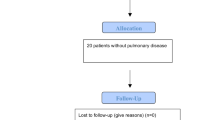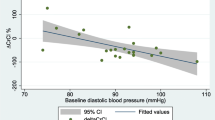Abstract
To investigate the effects of lung protective ventilation (LPV) compared to conventional ventilation (CV) on postoperative respiratory parameters in patients undergoing robot-assisted radical prostatectomy (RARP). In total, 24 patients undergoing RARP were randomized to two groups receiving either LPV with a tidal volume of 6 ml/IBW with a positive end-expiratory pressure (PEEP) of 10 cm H2O (intervention) or CV with a tidal volume of 10 ml/IBW with a PEEP of 4 cmH2O (control). Primary endpoint was PaO2 2 h postoperatively after 10 min of spontaneous respiration of atmospheric air. Forced expiratory volume during the first second (FEV1), forced vital capacity (FVC), diffusion capacity (DLCO), and plasma interleukin-6 (IL-6) was measured before and after the surgery. Pulmonary complications were registered within the first year after surgery. All patients completed the study. No difference was found in PaO2 between LPV and CV. However, 4 patients in the LPV group had a decrease in saturation below 90% during the 10 min of spontaneous respiration of atmospheric air compared to none in the CV group. FEV1, FVC, and DLCO were similar when comparing the two groups at all timepoints and no patients in either of the groups had pulmonary complications during the first postoperative year. IL-6 levels increased during surgery in both groups, but were not significantly different between the two groups. We found no evidence of lung protective effects of LPV compared to CV estimated by pulmonary function tests, IL-6 levels and postoperative complications in patients undergoing RARP. Surprisingly, only patients in the LPV group and none in the CV group had a decline in saturation below 90% during the 10 min of breathing atmospheric air.




Similar content being viewed by others
References
Ferlay J, Steliarova-Foucher E, Lortet-Tieulent J, Rosso S, Coebergh JW, Comber H, Forman D, Bray F (2013) Cancer incidence and mortality patterns in Europe: estimates for 40 countries in 2012. Eur J Cancer (Oxf, Eng: 1990) 49(6):1374–1403. https://doi.org/10.1016/j.ejca.2012.12.027
Ploussard G (2018) Robotic surgery in urology: facts and reality. What are the real advantages of robotic approaches for prostate cancer patients? Curr Opin Urol 28(2):153–158. https://doi.org/10.1097/mou.0000000000000470
Hedenstierna G, Tokics L, Strandberg A, Lundquist H, Brismar B (1986) Correlation of gas exchange impairment to development of atelectasis during anaesthesia and muscle paralysis. Acta Anaesthesiol Scand 30(2):183–191
Strandberg A, Tokics L, Brismar B, Lundquist H, Hedenstierna G (1986) Atelectasis during anaesthesia and in the postoperative period. Acta Anaesthesiol Scand 30(2):154–158
Danic MJ, Chow M, Alexander G, Bhandari A, Menon M, Brown M (2007) Anesthesia considerations for robotic-assisted laparoscopic prostatectomy: a review of 1500 cases. J Robot Surg 1(2):119–123. https://doi.org/10.1007/s11701-007-0024-z
Severgnini P, Selmo G, Lanza C, Chiesa A, Frigerio A, Bacuzzi A, Dionigi G, Novario R, Gregoretti C, de Abreu MG, Schultz MJ, Jaber S, Futier E, Chiaranda M, Pelosi P (2013) Protective mechanical ventilation during general anesthesia for open abdominal surgery improves postoperative pulmonary function. Anesthesiology 118(6):1307–1321. https://doi.org/10.1097/ALN.0b013e31829102de
Futier E, Constantin JM, Paugam-Burtz C, Pascal J, Eurin M, Neuschwander A, Marret E, Beaussier M, Gutton C, Lefrant JY, Allaouchiche B, Verzilli D, Leone M, De Jong A, Bazin JE, Pereira B, Jaber S (2013) A trial of intraoperative low-tidal-volume ventilation in abdominal surgery. N Engl J Med 369(5):428–437. https://doi.org/10.1056/NEJMoa1301082
Brower RG, Matthay MA, Morris A, Schoenfeld D, Thompson BT, Wheeler A (2000) Ventilation with lower tidal volumes as compared with traditional tidal volumes for acute lung injury and the acute respiratory distress syndrome. N Engl J Med 342(18):1301–1308. https://doi.org/10.1056/nejm200005043421801
Coppola S, Froio S, Chiumello D (2014) Protective lung ventilation during general anesthesia: is there any evidence? Crit Care (Lon, Engl) 18(2):210. https://doi.org/10.1186/cc13777
Annino F, Topazio L, Autieri D, Verdacchi T, De Angelis M, Asimakopoulos AD (2017) Robotic partial nephrectomy performed with Airseal versus a standard CO2 pressure pneumoperitoneum insufflator: a prospective comparative study. Surg Endosc 31(4):1583–1590. https://doi.org/10.1007/s00464-016-5144-y
Barbosa FT, Castro AA, de Sousa-Rodrigues CF (2014) Positive end-expiratory pressure (PEEP) during anaesthesia for prevention of mortality and postoperative pulmonary complications. Cochrane Database Syst Rev 6:Cd007922. https://doi.org/10.1002/14651858.cd007922.pub3
Guay J, Ochroch EA, Kopp S (2018) Intraoperative use of low volume ventilation to decrease postoperative mortality, mechanical ventilation, lengths of stay and lung injury in adults without acute lung injury. Cochrane Database Syst Rev 7:011151. https://doi.org/10.1002/14651858.cd011151.pub3
Guldner A, Kiss T, Serpa Neto A, Hemmes SN, Canet J, Spieth PM, Rocco PR, Schultz MJ, Pelosi P, Gama de Abreu M (2015) Intraoperative protective mechanical ventilation for prevention of postoperative pulmonary complications: a comprehensive review of the role of tidal volume, positive end-expiratory pressure, and lung recruitment maneuvers. Anesthesiology 123(3):692–713. https://doi.org/10.1097/aln.0000000000000754
Slutsky AS (1999) Lung injury caused by mechanical ventilation. Chest 116(1 Suppl):9s–15s
Hedenstierna G (2012) Oxygen and anesthesia: what lung do we deliver to the post-operative ward? Acta Anaesthesiol Scand 56(6):675–685. https://doi.org/10.1111/j.1399-6576.2012.02689.x
Acknowledgements
The authors greatly acknowledge nurse Brigitta Willumsen, all the nurses and anaesthesiologists of the Department of Anaesthesiology, urologists Lars Høst, MD, Stefan Vind-Kezunovic, MD, Morten Andersen, MD, Niels T. Mikkelsen, MD, and the nursing staff of the Department of Urology, for their help and practical assistance during the study. Furthermore, the authors thank the personnel of the laboratory.
Author information
Authors and Affiliations
Corresponding author
Ethics declarations
Conflict of interest
Jørgen Bjerggaard Jensen is proctor for Intuitive Surgery. Mette Mølsted, Peter Ekeløf, Jesper Nørgaard Bech, and Jost Wessels declare that they have no conflict of interest.
Additional information
Publisher's Note
Springer Nature remains neutral with regard to jurisdictional claims in published maps and institutional affiliations.
Rights and permissions
About this article
Cite this article
Mølsted, M., Ekeløf, P., Bech, J.N. et al. Effects of lung protective ventilation on postoperative respiratory parameters in patients undergoing robot-assisted radical prostatectomy. J Robotic Surg 14, 509–516 (2020). https://doi.org/10.1007/s11701-019-01016-y
Received:
Accepted:
Published:
Issue Date:
DOI: https://doi.org/10.1007/s11701-019-01016-y




